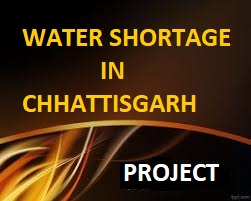Water Shortage In Chhattisgarh – A Disaster Management project
Water shortage in Chhattisgarh – A Disaster Management project requires research, analysis, and effective communication. Start your project with an introduction that briefly explains the problem of water shortage in Chhattisgarh, its causes, and its impact on the state’s population. Provide background information on the availability of water resources in Chhattisgarh, the state’s geography, and its climatic conditions. This information will help to understand the water shortage problem better. Analyze the causes and the impact of water shortage in Chhattisgarh, such as overuse and mismanagement of water resources, deforestation, industrialization, and inadequate rainfall. Also describe the government’s initiatives to address the water shortage problem in Chhattisgarh. This can include policies, schemes, and programs aimed at improving water management, increasing the availability of safe drinking water, and reducing water pollution.
A Project On Traditional Rainwater Harvesting in India: Preserving a Sustainable Water Source
Cover Page Design
The cover page of this project should include the title “Disaster Management Project on Water Shortage in Chhattisgarh,” along with relevant graphics and
images.
Title: Conserve Water, Secure the Future: A Call to Combat Water Shortage in Chhattisgarh
The Cover page features an image of a parched landscape with cracked earth and dried-up trees, representing the severity of the water shortage problem
in Chhattisgarh.
In the foreground, there is an image of a person holding a bucket of water, symbolizing the need for individuals to take responsibility for conserving water.
The title, “Conserve Water, Secure the Future,” is prominently displayed in bold letters.
Conveying the urgency of the situation and the need for immediate action.
The subtitle, “A Call to Combat Water Shortage in Chhattisgarh,” highlights the focus of the booklet.
The color scheme used is predominantly blue and green, representing the importance of water and nature.
Overall, the cover page design conveys the message of the need for collective action to combat water shortage in Chhattisgarh and secure a sustainable
future for the state.
Introduction
Chhattisgarh is a state in central India known for its rich forest resources, mineral deposits, and agricultural produce.
However, the state is facing a severe water crisis due to factors such as low rainfall, depletion of groundwater, and poor management of water resources.
The situation is further exacerbated by climate change, which is causing longer and more intense droughts.
The water crisis in Chhattisgarh is not only affecting the agriculture sector, but it is also impacting the lives and livelihoods of the people.
Women and children have to travel long distances to fetch water, and there have been reports of conflicts between communities over water resources.
To address this pressing issue, a disaster management project needs to be implemented to mitigate the impacts of water shortage in Chhattisgarh.
The project would aim to improve the management and distribution of water resources in the state.
Firstly, the project would focus on increasing the storage capacity of existing reservoirs and building new ones in areas with high water scarcity.
Secondly, it would involve the construction of check dams, percolation ponds, and recharge wells to recharge the groundwater.
Thirdly, the project would aim to promote the efficient use of water resources by adopting sustainable agricultural practices and encouraging the use of
drip irrigation.
The disaster management project would involve collaboration between the government, civil society organizations, and local communities to ensure the
sustainable management of water resources in Chhattisgarh.
By implementing such a project, the state can ensure access to clean and safe drinking water, and also revive the agriculture sector, which is the
backbone of the state’s economy.
The purpose of this project is to analyze the water shortage problem in Chhattisgarh and suggest measures to mitigate the issue.
Problem of Safe Drinking Water
The availability of safe drinking water is a significant concern in Chhattisgarh.
The state is rich in water resources, but the water is not adequately treated, leading to contamination.
This contamination is due to a lack of proper sanitation systems, the disposal of waste in water bodies, and the overuse of chemical fertilizers and
pesticides.
The high levels of contamination lead to various water-borne diseases such as cholera, typhoid, and dysentery.
The lack of safe drinking water is a significant problem, and it affects the health and wellbeing of the people of Chhattisgarh.
Causes Of Water Shortage In Chhattisgarh
Chhattisgarh, a state in central India, faces several challenges related to water scarcity despite having many rivers and water bodies.
Here are five causes of water shortage in Chhattisgarh:
Unequal distribution of water resources
Chhattisgarh has many rivers and water bodies, but the distribution of water resources is not uniform.
Some areas of the state have plenty of water, while others face a severe shortage.
Deforestation
Deforestation and land-use changes have led to a decline in water availability in Chhattisgarh.
Trees and vegetation help to retain water in the soil, and their removal can cause soil erosion and reduced water retention.
Rapid urbanization
Rapid urbanization in Chhattisgarh has put a strain on water resources.
Cities and towns require large amounts of water for their daily needs, and the increasing demand for water has led to shortages in many areas.
Climate change
Climate change is affecting the water availability in Chhattisgarh.
Changes in rainfall patterns, rising temperatures, and increasing evaporation rates are affecting water sources, making them more unreliable.
Agricultural practices
Agriculture is a major source of water consumption in Chhattisgarh, and traditional agricultural practices such as flood irrigation are highly inefficient.
The excessive use of water for irrigation, coupled with poor water management practices, is contributing to water scarcity in the state.
Impact of water shortage in Chhattisgarh
Water shortage in Chhattisgarh has several impacts on the environment, society, and economy.
Here are five impacts of water shortage in Chhattisgarh:
Agriculture and food production
Chhattisgarh is an agricultural state, and water scarcity can have a severe impact on crop yields and food production.
Farmers may not have enough water to irrigate their crops, leading to reduced yields and lower income.
Health and hygiene
Water scarcity can affect public health and hygiene in Chhattisgarh.
People may not have access to enough water for basic sanitation and hygiene practices, which can increase the risk of water-borne diseases.
Industrial development
Water scarcity can limit the growth of industries in Chhattisgarh that require large amounts of water for production.
This can negatively impact the state’s economy and result in job losses.
Wildlife and biodiversity
Water scarcity can impact the flora and fauna in Chhattisgarh.
Wildlife may be forced to migrate to areas with more water, and plant species that require a lot of water may struggle to survive.
Conflict and social unrest
Water scarcity can lead to conflict and social unrest in Chhattisgarh.
Communities may compete for limited water resources, and tensions may arise between different groups as a result.
Government’s initiatives to address the water shortage problem in Chhattisgarh
The government plays a crucial role in ensuring the availability of safe drinking water to its citizens.
In Chhattisgarh, the government has initiated several programs to address the water shortage problem.
The government has implemented schemes such as the Swachh Bharat Abhiyan, the Jal Jeevan Mission, and the Atal Bhujal Yojana.
The Swachh Bharat Abhiyan is aimed at improving sanitation and waste management in rural areas.
The Jal Jeevan Mission is focused on providing piped water supply to households in rural areas.
The Atal Bhujal Yojana is aimed at sustainable management of groundwater resources.
The government has initiated several measures to address this issue. Here are five of them:
Mukhyamantri Nal Jal Yojana
The government has launched the Mukhyamantri Nal Jal Yojana to provide piped drinking water to every household in the state.
Under this scheme, the government plans to set up water supply systems in rural and urban areas.
Interlinking of Rivers
The government is working on interlinking rivers to transfer water from water-rich areas to water-deficient areas.
The project is expected to benefit the state in the long term.
Rainwater Harvesting
The government is promoting the installation of rainwater harvesting systems in homes and public buildings.
This will help in conserving water and recharging the groundwater table.
Drought-Resistant Crops
The government is promoting the cultivation of drought-resistant crops that require less water and can withstand harsh weather conditions.
This will help farmers to mitigate the impact of water scarcity.
Conservation of Forests
The government is working towards the conservation of forests as they play a crucial role in maintaining the water cycle.
The state has launched several afforestation programs to increase the forest cover and improve the water-holding capacity of the soil.
The government should also take steps to prevent contamination of water bodies.
The government can enforce laws to regulate the disposal of waste in water bodies.
Also ban the use of chemical fertilizers and pesticides, and provide financial incentives to farmers to switch to organic farming.
Role of common man in combatting water shortage in Chhattisgarh
The common man can play a crucial role in combatting water shortage in Chhattisgarh.
The common man can contribute significantly towards combatting water shortage in Chhattisgarh.
By adopting sustainable water practices, educating and creating awareness among others, and actively participating in government initiatives.
Here are some ways in which they can contribute:
Water Conservation
The common man can contribute to water conservation by adopting practices such as rainwater harvesting,
using low-flow showerheads and taps, fixing leaks, and reusing water wherever possible.
This will help in reducing water wastage and conserving the precious resource.
Responsible Use
The common man can also contribute by using water responsibly.
For example, by turning off the tap while brushing teeth, limiting the use of sprinklers for gardening, and washing vehicles using a bucket.
This will help in reducing the demand for water and conserving it for essential purposes.
Education and Awareness
The common man can also play a role in educating and creating awareness about water conservation among their family, friends, and community.
By sharing information on the importance of water conservation and the need to adopt sustainable water practices, they can motivate others.
Participating in Government Programs
The common man can also participate in government programs such as the Mukhyamantri Nal Jal Yojana, rainwater harvesting programs, and
afforestation drives.
By actively participating in such initiatives, they can contribute to the larger goal of combatting water shortage in the state.
Conclusion
In conclusion, the water shortage problem in Chhattisgarh is a severe issue that needs immediate attention. The availability of safe drinking water is crucial for the health and wellbeing of the people. The government’s role in ensuring the availability of safe drinking water is critical. The government must implement programs that focus on improving sanitation and waste management, providing piped water supply to households, and sustainable management of groundwater resources. The government must also enforce laws to prevent contamination of water bodies and encourage farmers to switch to organic farming. The measures suggested in this project will go a long way in addressing the water shortage problem in Chhattisgarh.
You may be interested in:
Economics Project On Income Inequality: A Comprehensive Analysis For Class X
Social Science Project On Sustainable Development As Per Latest CBSE Guidelines
A Project On Traditional Rainwater Harvesting in India: Preserving a Sustainable Water Source





0 Comments